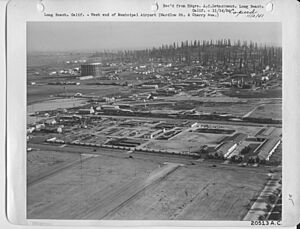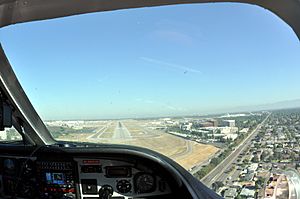Long Beach Airport facts for kids
Quick facts for kids
Long Beach Airport
|
|||||||||||||||||||||||
|---|---|---|---|---|---|---|---|---|---|---|---|---|---|---|---|---|---|---|---|---|---|---|---|
 |
|||||||||||||||||||||||
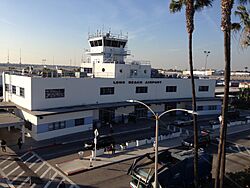 |
|||||||||||||||||||||||
| Summary | |||||||||||||||||||||||
| Airport type | Public | ||||||||||||||||||||||
| Owner | City of Long Beach | ||||||||||||||||||||||
| Serves | Greater Los Angeles | ||||||||||||||||||||||
| Location | Long Beach, California, U.S. | ||||||||||||||||||||||
| Elevation AMSL | 60 ft / 18 m | ||||||||||||||||||||||
| Coordinates | 33°49′04″N 118°09′06″W / 33.81778°N 118.15167°W | ||||||||||||||||||||||
| Map | |||||||||||||||||||||||
FAA airport diagram |
|||||||||||||||||||||||
| Runway | |||||||||||||||||||||||
|
|||||||||||||||||||||||
| [[Helipad|]] | |||||||||||||||||||||||
|
|||||||||||||||||||||||
| Statistics (2024) | |||||||||||||||||||||||
|
|||||||||||||||||||||||
|
Sources: FAA
|
|||||||||||||||||||||||
Long Beach Airport (IATA: LGB, ICAO: KLGB, FAA LID: LGB) is a public airport located about 3 miles (5 km) northeast of downtown Long Beach. It's in Los Angeles County, California, U.S.. The airport is also known as Daugherty Field, named after a famous local pilot, Earl Daugherty.
For a while, JetBlue used Long Beach Airport as a main base. However, they moved their flights to Los Angeles International Airport (LAX) in October 2020. This happened during the COVID-19 pandemic. After JetBlue left, Southwest Airlines became the biggest airline at Long Beach Airport.
The Federal Aviation Administration (FAA) considers it a "primary commercial service" airport. This means it's a key airport for passenger flights. In 2024, over 4.1 million passengers flew through Long Beach Airport.
Contents
About Long Beach Airport
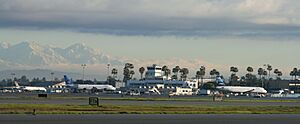
Long Beach Airport is located near the border of Los Angeles County and Orange County. It serves the larger Greater Los Angeles area. This airport handles many domestic passenger flights, cargo planes, military aircraft, and private planes. It is close to the much larger LAX, which is about 20 miles away.
Because the airport is near many homes, it has very strict rules about airplane noise. These rules are some of the toughest in the country.
Long Beach Airport is the 10th busiest airport in California for passenger flights. As of May 2025, Southwest Airlines flies the most planes from Long Beach. Other airlines like Delta and Hawaiian also offer flights. Cargo companies such as FedEx and UPS use LGB to transport goods. About 57,000 tons of cargo are moved through the airport each year.
Big companies like Boeing (which used to be McDonnell Douglas) have maintenance facilities near the airport. They used to build the C-17 cargo plane here until 2015. Other companies like Mercedes-Benz, Relativity Space, Virgin Galactic, and Gulfstream Aerospace also have operations at or near the airport.
The airport has a special program to reduce noise. Three full-time experts work to manage noise. If pilots or plane owners break the noise rules, the City of Long Beach can take legal action. As more planes use the airport, there are more complaints about loud, low-flying aircraft. The airport publishes a report each month about noise and complaints.
Because of these noise rules, there have been limits on commercial flights since 1981. Currently, there are 41 permanent daily flights allowed. There are also up to 17 extra flights that can be added each year, depending on how well the airport manages noise. This makes a total of 58 flights per day. However, many other types of planes use the airport, like private jets, flight school planes, police aircraft, helicopters, and advertising blimps. Long Beach Airport is one of the busiest airports in the world for general aviation (private planes).
The main terminal building at Long Beach Airport has a cool Streamline Moderne style. It's a historic landmark and was updated in 2013. ATP Flight School also trains future commercial pilots here.
Airport History
The very first flight across the United States landed on Long Beach's sandy beach in 1911. It was a biplane flown by Calbraith Perry Rodgers. For many years, planes used the beach as a runway.
A pilot named Earl S. Daugherty rented the land where the airport is now. He put on air shows, did stunt flying, and gave rides. In 1919, he started the world's first flight school there. In 1923, Daugherty convinced the city to turn the area into its first official airport.
A famous pilot named Douglas "Wrong Way" Corrigan often flew from Daugherty Field. In 1938, he flew from Long Beach to New York. He wanted to fly to Ireland, but officials said no. He was supposed to fly back to Long Beach. Instead, he ended up in Ireland! He said it was a mistake with his navigation.
The main terminal building was built in 1941. It was designed by architects William Horace Austin and Kenneth Smith Wing. Inside, you can see murals and mosaics created by artist Grace Clements. These artworks, finished in 1941, show themes of aviation, navigation, and stars.
In the early days, flights from Long Beach Airport only went to nearby cities like Los Angeles and San Diego. Jet flights started in 1968. Over the years, many airlines have come and gone. In 2020, JetBlue stopped flying from Long Beach. This made Southwest Airlines the main carrier.
Military Use During World War II
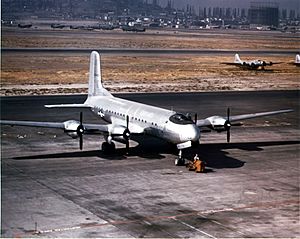
To support the United States Navy, the City of Long Beach built hangars and buildings. They leased them to the Navy for a very low price to create a Naval Reserve air base in 1928. The city also built facilities for the United States Army Air Corps.
During World War II, the airport became very important for the war effort. The Civil Aeronautics Administration took control of the airport in 1941. It grew to cover 500 acres. The Navy used it as a Naval Auxiliary Air Station (NAAS) to service many types of military aircraft.
The Long Beach Army Airfield became a base for the Army's Air Transport Command. They had a Ferrying Division that included a squadron of 18 women pilots.
Douglas Aircraft built a huge factory near the airport in 1940. They produced many planes for the war. Their first C-47 plane was delivered just 16 days after the attack on Pearl Harbor. During the war, they built over 4,200 C-47s, about 1,000 A-20 Havocs, 3,000 B-17 Flying Fortresses, and 1,156 A-26 Invaders.
After the war ended, the U.S. Navy no longer used Long Beach Municipal Airport.
Airport Facilities
Long Beach Airport covers 1,166 acres (472 hectares) of land. It sits at an elevation of 60 feet (18 meters) above sea level. The airport has three asphalt runways:
- Runway 12/30 is 10,000 feet (3,048 meters) long.
- Runway 8L/26R is 6,192 feet (1,887 meters) long.
- Runway 8R/26L is 3,918 feet (1,194 meters) long.
It also has four helipads for helicopters. Two runways (16L/34R and 16R/34L) were permanently closed and removed in 2016.
In the year ending November 1, 2023, the airport had almost 375,000 aircraft movements. This means planes took off or landed about 1,027 times each day. Most of these were general aviation (private planes), with 9% being airline flights. There are 398 aircraft based at the airport, including single-engine planes, multi-engine planes, jets, and helicopters.
Airlines and Destinations
Passenger Flights
| Airlines | Destinations | Refs |
|---|---|---|
| Delta Air Lines | Salt Lake City | |
| Delta Connection | Salt Lake City | |
| Hawaiian Airlines | Honolulu, Kahului | |
| Southwest Airlines | Albuquerque, Austin, Baltimore, Chicago–Midway, Dallas–Love, Denver, El Paso, Honolulu, Houston–Hobby, Las Vegas, Nashville, Oakland, Phoenix–Sky Harbor, Reno/Tahoe, Sacramento, Salt Lake City, San Jose (CA) Seasonal: Kahului, New Orleans, Orlando, St. Louis |
Cargo Flights
| Airlines | Destinations |
|---|---|
| FedEx Express | Fort Worth/Alliance |
| UPS Airlines | Louisville |
Destinations Map
| Destinations map |
|---|
Airport Statistics
Most Popular Destinations
| Rank | City | Passengers | Airlines |
|---|---|---|---|
| 1 | 263,000 | Southwest | |
| 2 | 208,000 | Southwest | |
| 3 | 175,000 | Southwest | |
| 4 | 171,000 | Southwest | |
| 5 | 146,000 | Delta, Southwest | |
| 6 | 134,000 | Southwest | |
| 7 | 119,000 | Hawaiian, Southwest | |
| 8 | 118,000 | Southwest | |
| 9 | 90,000 | Southwest | |
| 10 | 90,000 | Southwest |
| Rank | Airline | Passengers | Share |
|---|---|---|---|
| 1 | Southwest Airlines | 2,794,000 | 84.82% |
| 2 | Hawaiian Airlines | 228,000 | 6.92% |
| 3 | SkyWest Airlines | 195,000 | 5.91% |
| 4 | Mesa Airlines | 74,910 | 2.27% |
| 5 | Delta Air Lines | 2,230 | 0.07% |
| 6 | Other | 300 | 0.01% |
Yearly Passenger Traffic
| Year | Passengers | Year | Passengers | Year | Passengers |
|---|---|---|---|---|---|
| 2000 | 637,853 | 2010 | 2,978,426 | 2020 | 1,043,773 |
| 2001 | 587,473 | 2011 | 3,099,488 | 2021 | 2,104,696 |
| 2002 | 1,453,551 | 2012 | 3,206,910 | 2022 | 3,242,831 |
| 2003 | 2,875,525 | 2013 | 2,942,873 | 2023 | 3,739,307 |
| 2004 | 2,926,873 | 2014 | 2,823,996 | 2024 | 4,148,080 |
| 2005 | 3,034,032 | 2015 | 2,523,686 | 2025 | |
| 2006 | 2,758,362 | 2016 | 2,852,294 | 2026 | |
| 2007 | 2,906,556 | 2017 | 3,783,805 | 2027 | |
| 2008 | 2,913,926 | 2018 | 3,884,721 | 2028 | |
| 2009 | 2,909,307 | 2019 | 3,584,203 | 2029 |
Getting to and from the Airport
Long Beach Transit offers several bus routes that serve the airport. Routes 102, 104, 111, and 176 can take you there. For example, Route 111 goes to Downtown Long Beach Station. From there, you can connect to the A Line train to reach downtown Los Angeles. Route 104 connects to the Willow Street Station.
The San Diego Freeway (I-405) is easily reached from the airport using Lakewood Boulevard (SR 19). Wardlow Road runs from the airport to the border of Los Angeles and Orange Counties. It then becomes Ball Road, which passes near Disneyland Resort. Long Beach Airport is the second closest airport to Disneyland, after John Wayne Airport.
Airport Upgrades
On December 12, 2012, Long Beach Airport finished a big $136 million upgrade project. The goal was to make the main terminal modern while keeping its historic Art Deco style. The project added cool features like a central palm garden, outdoor dining areas with fire pits, and wine bars. A new parking garage with 2,000 spaces was also built. About $5 million was spent to fix up the old terminal, which was built in 1941 and is a city landmark. The new terminal still feels open-air, and passengers walk across the tarmac to board planes. The baggage claim area is also partly open.
In February 2020, the Long Beach City Council approved another $80-million upgrade project. This project includes a new building for ticketing and making the historic terminal stronger against earthquakes. It also involves moving the rental car area into the historic terminal, creating new baggage claim areas, and a new place for people to meet arriving passengers. This work started in 2020 and is expected to finish in early 2024.
Movies and Television
The airport has appeared in several movies:
- Executive Suite
- Rush Hour (1998 film)
- The Bachelor and the Bobby-Soxer
- The Parent Trap (1998 film)
Images for kids
See also
 In Spanish: Aeropuerto de Long Beach para niños
In Spanish: Aeropuerto de Long Beach para niños
- California World War II Army Airfields
- Western Air Defense Force


